水生生物水质基准是水质基准的重要组成部分,它反映有毒物质对水生生物或水体功能不产生长期和短期不利影响的最高浓度,推导该基准值有利于了解水生生物正常生存代谢的水环境要求,有助于维持水环境生态系统的相对稳定[1]。目前,国内外学者重点针对镉[2]、锌[2]、铅[3]、铬[3]和银[4]等重金属和二甲苯[5]、2,4-二氯苯酚[6]等有机物以及氨氮[7]等无机非金属物对水生生物的水质基准研究和推导,但关于除草剂的水质基准推导尚未全面展开,且草甘膦基准值推导存在空白,因此有必要对草甘膦的水生生物基准进行研究。《淡水水生生物水质基准制定技术指南》(HJ 831—2017)[8]的实施以及2022年该技术指南的修订征求意见稿[9]发布,提高了推导出的水质基准值的可靠性,加速推进我国水生生物水质基准研究,为本项研究的顺利进行提供了基础。
草甘膦是一种广泛使用的除草剂,主要经地表径流和土壤渗透等不同途径进入水域,据调查,我国河南、江苏、广东和贵州等省份淡水水域中都有检测出草甘膦[10]。草甘膦具有微溶于水的特点,其存留在水环境中的半衰期较长,约为47 d,会连续不断危害水生态系统,从而影响水生生物的生理代谢活动,甚至会导致水生生物死亡[11]。草甘膦能抑制藻类和高等植物体内的5-烯醇丙酮草莽酸-3-膦酸盐合成酶的活性[12],阻碍生物体内合成芳香族氨基酸(包括色氨酸、酪氨酸和苯丙氨酸),从而对绿色植物产生毒性作用[12]。草甘膦能促进水生生物肝脏产生大量自由基,进而使生物出现血液血球体积变大以及产生大量白细胞的现象,最终导致生物无法正常存活代谢[13]。为避免草甘膦对淡水水生生物和水环境生态系统造成不可接受的影响,因此有必要推导草甘膦的水质基准值,以期为评估草甘膦的毒性效应及生态风险提供科学依据。
水质基准的研究结果可为水环境风险评估、水环境质量评价以及相关政策制定提供理论依据,同时可为水质标准的完善奠定基础[14]。纵观国内外学者研究,毒性百分数排序法(toxicity percentage rank method, TPR)和物种敏感度分布法(toxicity percentage rank method, SSD)较为常见[15],研究者们通常使用这2种方法推导水质基准值。目前,缺乏关于草甘膦水质基准的研究,因此本研究对草甘膦的淡水水生生物毒性数据进行收集筛选,并通过TPR法和SSD法推导出草甘膦淡水水生生物水质基准值。此外,本文收集国内外地表水中草甘膦含量数据,并结合SSD法推导的水质基准值和商值法(risk quotient method, RQ)进行生态风险评估。
1 材料与方法(Materials and methods)
1.1 毒理学数据的收集和筛选
1.1.1 数据收集
本文关于草甘膦的淡水水生生物毒性数据获取自美国环境保护局ECOTOX毒性数据库(http://cfpub.epa.gov/ecotox/)、中国知网(http://www.cnki.com/)和Web of Science(http://apps.webofknowledge.com/)检索出的文献,全部数据于2022年1月29日收集完成。
1.1.2 数据筛选原则
依据《淡水水生生物水质基准制定技术指南》和美国环境保护局(US EPA)1985年水质基准文件[1]进行物种筛选,筛选出的物种包括的营养级数≥3。
根据标准规定,选取半数致死浓度(lethal concentration of 50%, LC50)或半数效应浓度(effect concentration of 50%, EC50)作为急性毒性指标终点,无观察效应浓度(no observed effect concentration, NOEC)或最低可观察浓度(lowest observed effect concentration, LOEC)作为慢性毒性指标终点[14,16-19]。推导的水质基准值与毒性数据的质量有密切的关系,为获得高精度的草甘膦水质基准值,本研究中蚤类、其他枝角类或摇蚊幼虫的急性毒性试验指标优先选择48 h-LC50或者48 h-EC50,鱼类及其他生物优先选择96 h-LC50或者96 h-EC50。优先选择测试草甘膦纯度≥80%的数据;实验过程中溶解氧>60%,总有机碳和颗粒物浓度<5 mg·L-1;实验用水为标准稀释水,且必须设置对照组(空白、助溶剂对照组等),优先采用流水式实验数据;不采用以细胞动物为受试物种的实验数据;急性毒性效应测试终点(LC50/EC50)数据使用暴露时间≤4 d的毒性数据;慢性毒性效应测试终点(NOEC和LOEC)数据优先使用暴露时间≥14 d的毒性数据[20];当同一物种毒性终点数据满足上述要求且适用时,优先使用最敏感毒性终点数据;最终取多个毒性终点数据的几何平均值作为该物种的最终毒性数据[21]。全部毒性数据单位统一为mg·L-1。
1.1.3 筛选结果
按照上述标准进行筛选,本研究共收集29个种平均急性值,涵盖5门16科29种,各物种详细数据如表1所示。本研究共收集13个种平均慢性值,涵盖3门8科13种,各物种详细数据如表2所示。
表1 草甘膦的水生生物急性毒性数据
Table 1 Acute aquatic toxicity data of glyphosate
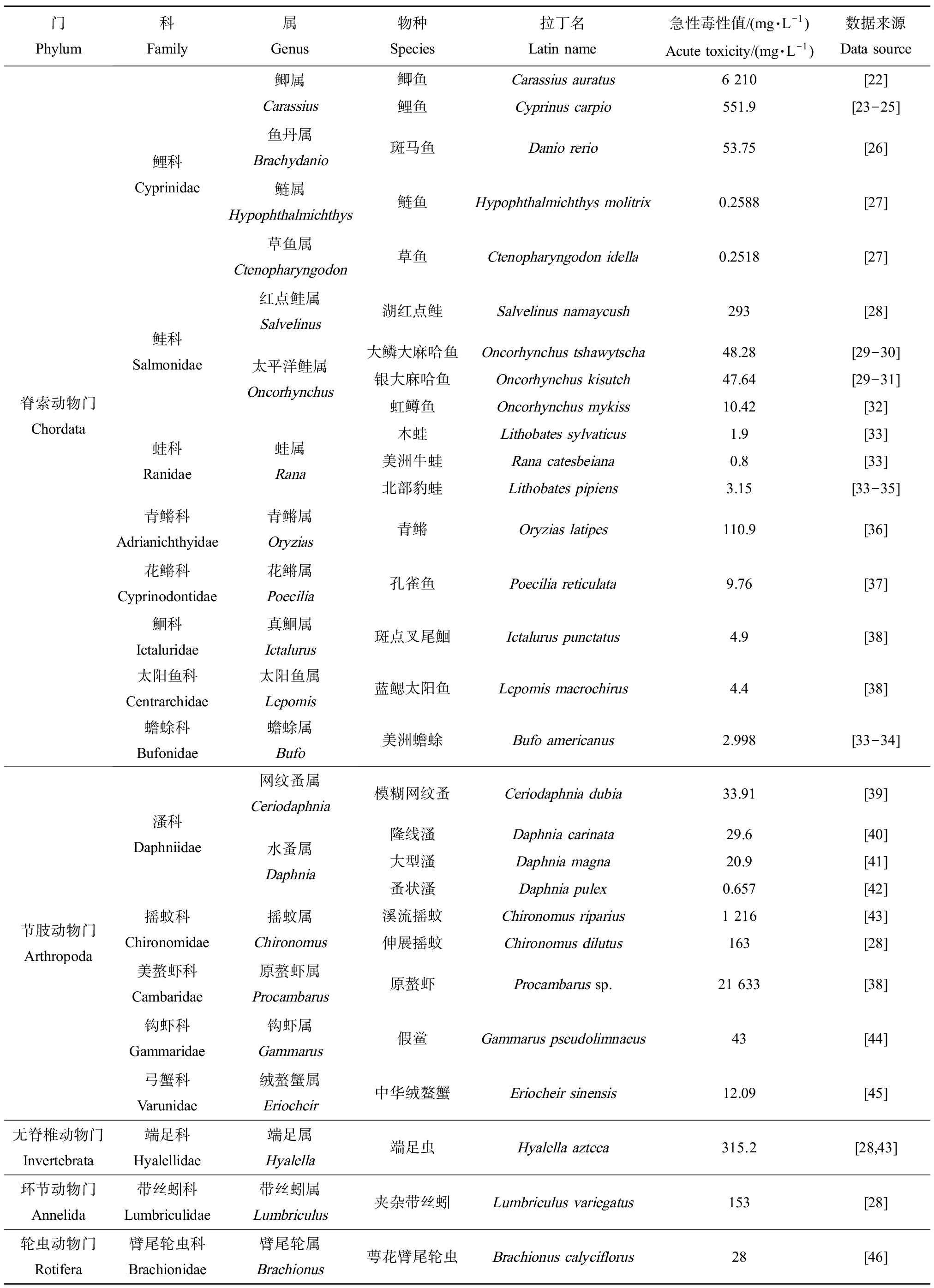
门Phylum科Family属Genus物种Species拉丁名Latin name急性毒性值/(mg·L-1 )Acute toxicity/(mg·L-1 )数据来源Data source脊索动物门Chordata鲤科Cyprinidae鲑科Salmonidae蛙科Ranidae青鳉科Adrianichthyidae花鳉科Cyprinodontidae鮰科Ictaluridae太阳鱼科Centrarchidae蟾蜍科Bufonidae鲫属Carassius鱼丹属Brachydanio鲢属Hypophthalmichthys草鱼属Ctenopharyngodon红点鲑属Salvelinus太平洋鲑属Oncorhynchus蛙属Rana青鳉属Oryzias花鳉属Poecilia真鮰属Ictalurus太阳鱼属Lepomis蟾蜍属Bufo鲫鱼Carassius auratus6 210[22]鲤鱼Cyprinus carpio551.9[23-25]斑马鱼Danio rerio53.75[26]鲢鱼Hypophthalmichthys molitrix0.2588[27]草鱼Ctenopharyngodon idella0.2518[27]湖红点鲑Salvelinus namaycush293[28]大鳞大麻哈鱼Oncorhynchus tshawytscha48.28[29-30]银大麻哈鱼Oncorhynchus kisutch47.64[29-31]虹鳟鱼Oncorhynchus mykiss10.42[32]木蛙Lithobates sylvaticus1.9[33]美洲牛蛙Rana catesbeiana0.8[33]北部豹蛙Lithobates pipiens3.15[33-35]青鳉Oryzias latipes110.9[36]孔雀鱼Poecilia reticulata9.76[37]斑点叉尾鮰Ictalurus punctatus4.9[38]蓝鳃太阳鱼Lepomis macrochirus4.4[38]美洲蟾蜍Bufo americanus2.998[33-34]节肢动物门Arthropoda溞科Daphniidae摇蚊科Chironomidae美螯虾科Cambaridae钩虾科Gammaridae弓蟹科Varunidae网纹蚤属Ceriodaphnia水蚤属Daphnia摇蚊属Chironomus原螯虾属Procambarus钩虾属Gammarus绒螯蟹属Eriocheir模糊网纹蚤Ceriodaphnia dubia33.91[39]隆线溞Daphnia carinata29.6[40]大型溞Daphnia magna20.9[41]蚤状溞Daphnia pulex0.657[42]溪流摇蚊Chironomus riparius1 216[43]伸展摇蚊Chironomus dilutus163[28]原螯虾Procambarus sp.21 633[38]假鲎Gammarus pseudolimnaeus43[44]中华绒鳌蟹Eriocheir sinensis12.09[45]无脊椎动物门Invertebrata端足科Hyalellidae端足属Hyalella端足虫Hyalella azteca315.2[28,43]环节动物门Annelida带丝蚓科Lumbriculidae带丝蚓属Lumbriculus夹杂带丝蚓Lumbriculus variegatus153[28]轮虫动物门Rotifera臂尾轮虫科Brachionidae臂尾轮属Brachionus萼花臂尾轮虫Brachionus calyciflorus28[46]
表2 草甘膦的水生生物慢性毒性数据
Table 2 Chronic aquatic toxicity data of glyphosate
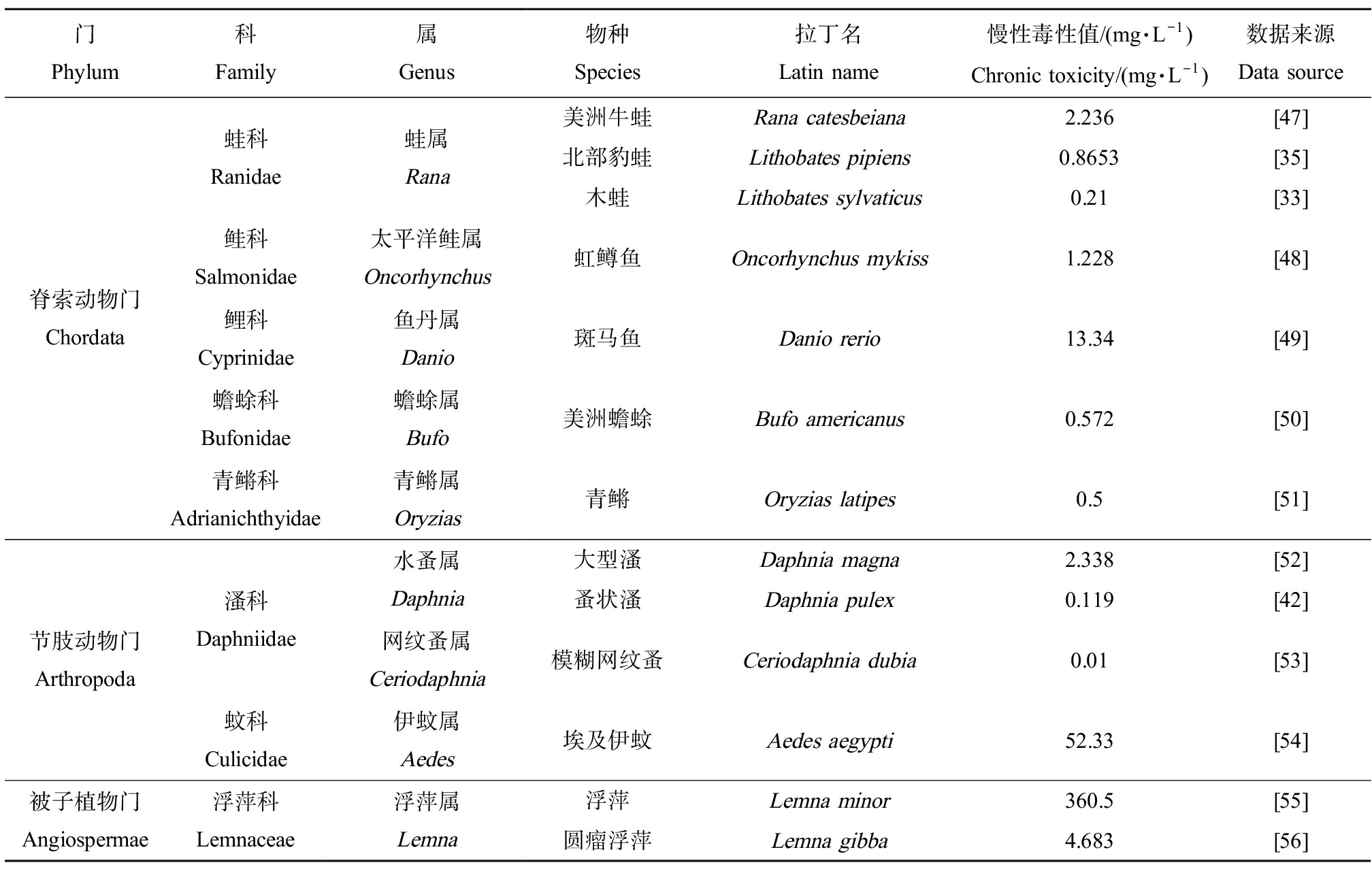
门Phylum科Family属Genus物种Species拉丁名Latin name慢性毒性值/(mg·L-1 )Chronic toxicity/(mg·L-1 )数据来源Data source脊索动物门Chordata蛙科Ranidae蛙属Rana鲑科Salmonidae太平洋鲑属Oncorhynchus鲤科Cyprinidae鱼丹属Danio蟾蜍科Bufonidae蟾蜍属Bufo青鳉科Adrianichthyidae青鳉属Oryzias美洲牛蛙Rana catesbeiana2.236[47]北部豹蛙Lithobates pipiens0.8653[35]木蛙Lithobates sylvaticus0.21[33]虹鳟鱼Oncorhynchus mykiss1.228[48]斑马鱼Danio rerio13.34[49]美洲蟾蜍Bufo americanus0.572[50]青鳉Oryzias latipes0.5[51]节肢动物门Arthropoda溞科Daphniidae蚊科Culicidae水蚤属Daphnia网纹蚤属Ceriodaphnia伊蚊属Aedes大型溞Daphnia magna2.338[52]蚤状溞Daphnia pulex0.119[42]模糊网纹蚤Ceriodaphnia dubia0.01[53]埃及伊蚊Aedes aegypti52.33[54]被子植物门Angiospermae浮萍科Lemnaceae浮萍属Lemna浮萍Lemna minor360.5[55]圆瘤浮萍Lemna gibba4.683[56]
1.2 水生生物水质基准推导方法
1.2.1 毒性百分数排序法
TPR法是US EPA推荐使用的标准方法,该方法分别利用了淡水水生生物急性和慢性毒性数据,并结合统计学方法推导基准值。该方法基准值为基准最大浓度(criteria maximum concentration, CMC)和基准连续浓度(criteria continuous concentration, CCC),分别来自污染物的急性毒性和慢性毒性效应,且CMC为最终急性值(final acute value, FAV)的1/2;CCC为最终慢性值(final chronic value, FCV)、最终植物值(final plant value, FPV)、最终残留值(final residual value, FRV)中的最小值[57]。
TPR法需要分别将收集到的29个急性毒性数据和13个慢性毒性数据进行正态分布检验,并将异常数据进行对数转换后,再次重新检验。处理后的数据需按升序排列,按最小毒性值的等级为1,最大毒性值等级为N分配相应等级R[8]。各生物毒性值的积累概率公式如下:
(1)
式中:P为积累概率;R为物种排序的等级;N为物种的个数。
选择4个累积概率最接近0.05的属平均急性值(generic mean acute value, GMAV),GMAV为属所包含物种的急性毒性数据的几何平均值。
FAV值按式(2)~式(5)计算:
(2)
(3)
(4)
FAV=eA
(5)
式中:S、L、A为计算符号;GMAV为属平均急性值;P为累积概率;FAV为最终急性值。
属平均慢性值(generic mean chronic value, GMCV)和FCV可分别参考GMAV和FAV的方法计算获取。
FPV为藻类的96 h急性实验或水生维管束植物的慢性实验最小值;FRV为物质的最大允许组织浓度与生物富集因子(或生物累计因子)之比。
1.2.2 物种敏感度分布法
SSD法可推算出保护95%水生生物不受影响的水环境中污染物阈值,通常用随机水生生物的毒性数据拟合曲线模型,并用计算出的生态风险阈值HC5来表示。本研究基于水生生物的急性毒性值,推导草甘膦的短期水质基准(short-term water quality criterion, SWQC);基于水生生物的慢性毒性值,推导草甘膦的长期水质基准(long-term water quality criterion, LWQC)。
利用中国环境科学研究院发布的“国家生态基准计算软件-物种敏感度分布法(EEC-SSD)”进行数据拟合,模型拟合评价参数包括决定系数(R2)、均方根(root mean-square error)和概率P值(K-S检验):R2越接近1,表明拟合优度越大;RMSE越接近于0,表明模型拟合的精确度越高;P值>0.05,表明模型符合理论分布[58]。随后依据拟合结果得到的HC5值进行水质基准计算,具体计算公式如下:
SWQC=HC5急性/AF
LWQC=HC5慢性/AF
式中:AF为评价因子,当所收集的有效毒性数据量超过15个时,AF取2;有效毒性数据≤15时,AF一般取值为3[9]。
1.3 生态风险评价
本研究运用RQ法计算出的急性和慢性风险商对国内外报道的含草甘膦淡水水域进行生态风险初步评价,其中,急性风险商为水环境中草甘膦浓度最大值与其短期基准值的商,慢性风险商为草甘膦浓度平均值与其长期基准值的商[13]。当RQ<0.1时,说明该水域草甘膦暴露浓度很低,水环境无风险;当0.1≤RQ<1时,说明该水域草甘膦暴露浓度较低,水环境相对安全;当1≤RQ<10时,说明该水域草甘膦暴露浓度一般,水环境安全程度适中;当风险商值RQ≥10时,说明该水域草甘膦暴露浓度较高,水环境相对危险,其风险程度与风险商值呈正比关系[59-60]。
1.4 数据分析软件
本研究实验数据用SPSS 22.0软件进行统计学分析,并利用Excel 2021对数据进行整理分析。利用中国环境科学研究院发布的“国家生态基准计算软件-物种敏感度分布法(EEC-SSD)”进行数据拟合。
2 结果(Results)
2.1 TPR法推导水质基准
经TPR法处理的数据如表3所示,其中草鱼属、鲢属、蛙属和蟾蜍属的累积概率接近0.05,经计算得到草甘膦的FAV值为0.25 mg·L-1;由于收集的数据所涵盖的物种数超过15,CMC取值应为FAV的一半,故草甘膦的淡水CMC为0.12 mg·L-1。同上,如表4所示,网纹蚤属、青鳉属、水蚤属和蟾蜍属的累积概率接近0.05,按照毒性百分数排序法计算FCV,得到草甘膦在淡水中的FCV=0.035 mg·L-1。
表3 属平均急性值及累积概率
Table 3 Generic mean acute value and cumulative probability
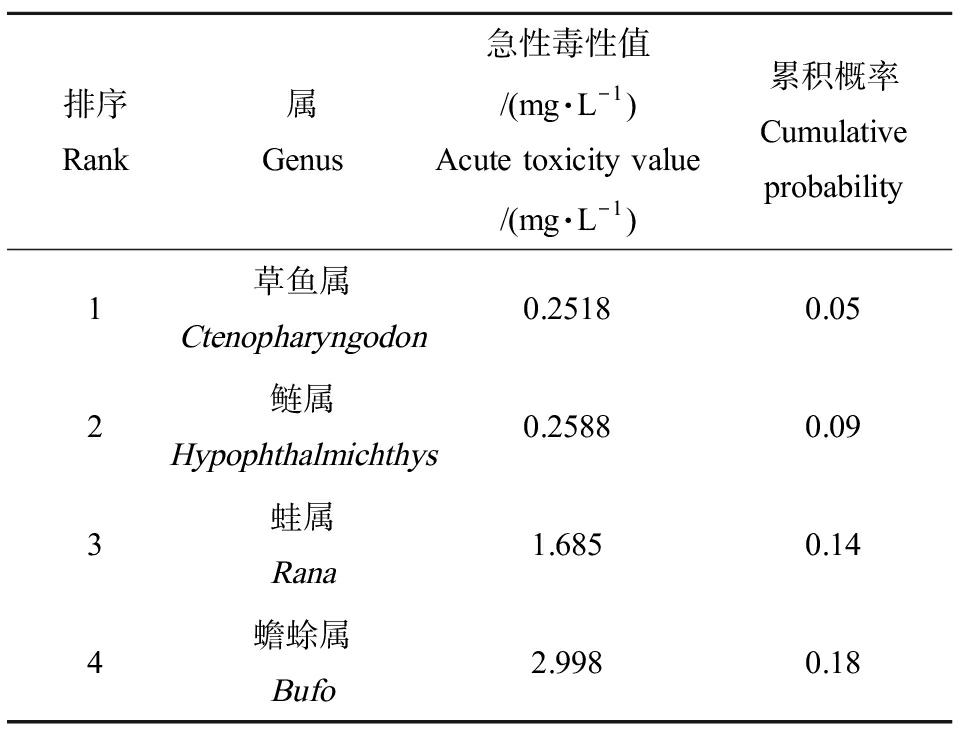
排序Rank属Genus急性毒性值/(mg·L-1)Acute toxicity value/(mg·L-1)累积概率Cumulative probability1草鱼属Ctenopharyngodon0.25180.052鲢属Hypophthalmichthys0.25880.093蛙属Rana1.6850.144蟾蜍属Bufo2.9980.18
表4 属平均慢性值及累积概率
Table 4 Generic mean chronic value and cumulative probability

排序Rank属Genus慢性毒性值/(mg·L-1 )Chronic toxicity value/(mg·L-1 )累积概率Cumulative probability1网纹蚤属Ceriodaphnia0.010.12青鳉属Oryzias0.50.23水蚤属Daphnia0.5270.34蟾蜍属Bufo0.5720.4
将水生维管束植物类慢性毒性数据最小值作为FPV值,即FPV值为圆瘤浮萍慢性毒性值4.683 mg·L-1。可食用水产品含草甘膦最大残留限量尚未规定,故选用我国《食品安全国家标准 食品中农药最大残留限量》(GB 2763—2019)规定的草甘膦每日允许摄入量0.1 mg·kg-1作为FRV。草甘膦的CCC取FCV、FRV和FPV中的最小值,即CCC=0.035 mg·L-1。综上,草甘膦的CMC和CCC值分别为0.12 mg·L-1和0.035 mg·L-1。
2.2 SSD法推导水质基准
经K-S检验,收集的29个急性毒性数据的对数值满足正态分布![]() 可用于SWQC值的推导。以毒性数据的对数值为横坐标,累积概率值为纵坐标绘制SSD曲线,通过EEC-SSD软件中多种非线性函数模型对处理后的数据进行拟合,得到了相应拟合曲线,其中Normal、Log-normal和Logistic这3种模型的R2均>91%,拟合图形如图1所示。结合急性毒性数据模型拟合评价参数(表5),Logistic模型的R2最大且RMSE最小,故该模型对急性毒性数据的拟合结果最好,选择该模型数据推导水质基准值,其中HC5为0.28 mg·L-1,由AF取值2,则SWQC为0.14 mg·L-1。
可用于SWQC值的推导。以毒性数据的对数值为横坐标,累积概率值为纵坐标绘制SSD曲线,通过EEC-SSD软件中多种非线性函数模型对处理后的数据进行拟合,得到了相应拟合曲线,其中Normal、Log-normal和Logistic这3种模型的R2均>91%,拟合图形如图1所示。结合急性毒性数据模型拟合评价参数(表5),Logistic模型的R2最大且RMSE最小,故该模型对急性毒性数据的拟合结果最好,选择该模型数据推导水质基准值,其中HC5为0.28 mg·L-1,由AF取值2,则SWQC为0.14 mg·L-1。
表5 急性毒性数据模型拟合评价参数
Table 5 Model fitting evaluation parameters of acute toxicity data

非线性函数模型Nonlinear functional model拟合公式 Fitting equationHC5R2RMSEP(K-S)Normaly=12πσe--[x-μ]22σ20.740.960.058>0.05Log-normaly=y0+A2πσxe-[lnxμ]22σ23.090.920.081>0.05Logisticy=A1-A21+(x/x0)p+A20.280.990.026>0.05
注:x、y、p为变量;A、A1、A2、y0、x0为常量;μ为均数;σ为标准差。
Note: x, y, pare variables; A, A1, A2, y0, x0are constants; μis mean; σis standard deviation.
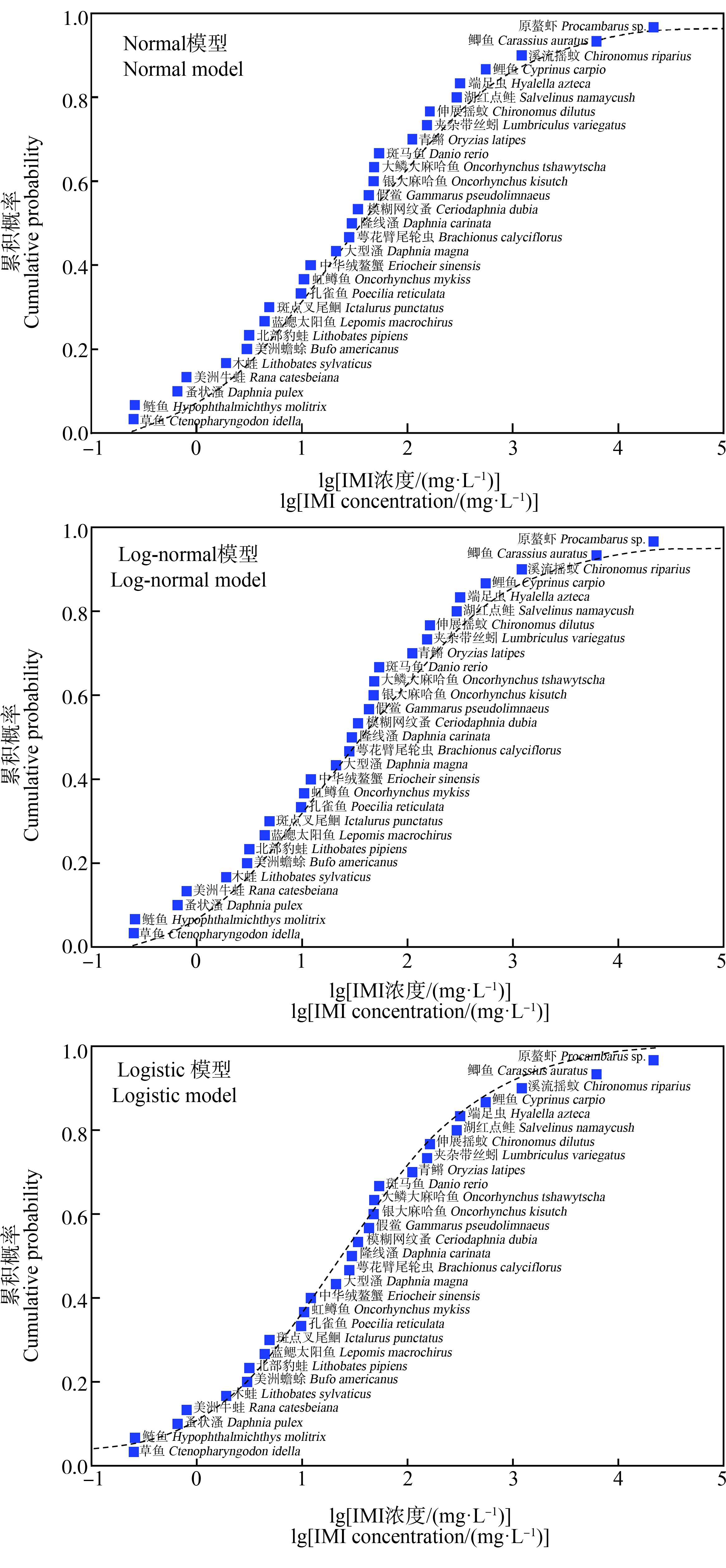
图1 草甘膦的急性物种敏感度分布曲线
注:IMI表示吡虫啉。
Fig.1 The acute species sensitivity distribution curves for glyphosate
Note: IMI means imidacloprid.
同上,经K-S检验,收集的13个慢性毒性数据的对数值满足正态分布![]() 可用于LWQC的推导。利用EEC-SSD软件中多种非线性函数模型拟合13个慢性毒性数据,得到了相应拟合曲线,其中Normal、Logistic这2种模型的R2均>95%,拟合图形如图2所示。结合慢性毒性数据模型拟合评价参数(表6),Logistic模型的R2最大且RMSE最小,故该模型对慢性毒性数据的拟合结果最好,选择该模型数据推导水质基准值,其中HC5为0.02 mg·L-1,由AF取值3,则LWQC为0.007 mg·L-1。
可用于LWQC的推导。利用EEC-SSD软件中多种非线性函数模型拟合13个慢性毒性数据,得到了相应拟合曲线,其中Normal、Logistic这2种模型的R2均>95%,拟合图形如图2所示。结合慢性毒性数据模型拟合评价参数(表6),Logistic模型的R2最大且RMSE最小,故该模型对慢性毒性数据的拟合结果最好,选择该模型数据推导水质基准值,其中HC5为0.02 mg·L-1,由AF取值3,则LWQC为0.007 mg·L-1。
表6 慢性毒性数据模型拟合评价参数
Table 6 Model fitting evaluation parameters of chronic toxicity data

非线性函数模型Nonlinear functional model拟合公式 Fitting equationHC5R2RMSEP(K-S)Normaly=12πσe--[x-μ]22σ20.040.960.056>0.05Log-normaly=y0+A2πσxe-[lnxμ]22σ21.59-0.270.302<0.05Logisticy=A1-A21+(x/x0)p+A20.020.980.036>0.05
注:x、y、p为变量;A、A1、A2、y0、x0为常量;μ为均数;σ为标准差。
Note: x, y, pare variables; A, A1, A2, y0, x0are constants; μis mean; σis standard deviation.

图2 草甘膦的慢性物种敏感度分布曲线
Fig. 2 The chronic species sensitivity distribution curves for glyphosate
2.3 世界地表水中草甘膦生态风险评价
国内外报道中,在淡水水域中检测到草甘膦的文献较少,故本文收集了世界各地仅有的草甘膦淡水水环境暴露数据,如表7所示。草甘膦的暴露平均浓度范围为0~6 760 μg·L-1,其中以我国江苏省南京市太湖地表水中的草甘膦浓度最高,高达6 760 μg·L-1,远超其他水域中草甘膦含量。根据RQ法计算各地水体的急性、慢性风险商,结果如表7所示。据统计,各地表水急性风险商范围为0~371.8,平均值为15.2;各地表水慢性风险商范围为0~965.7,平均值为41.7。其中,7.69%的水体为急性高风险水体,7.69%的水体为 急性中风险水体,15.38%的水体为急性低风险水体,69.23%的水体为无风险水体,故急性风险商中,主要以无风险为主;而在慢性风险商中,主要以低风险为主,15.38%的水体为高风险,3.85%的水体为中风险,42.31%的水体为低风险,38.46%的水体为无风险。
表7 草甘膦的生态风险商值
Table 7 Ecological risk quotient of glyphosate

区域Area平均含量/(μg·L-1)Mean content/(μg·L-1)最大含量/(μg·L-1)Max content/(μg·L-1)急性风险商Acute risk quotient慢性风险商Chronic risk quotient数据来源Data source中国China贵州省贵阳市地表水Surface water in Guiyang, Guizhou Province6.173.20.5230.871[10]浙江省嘉兴市、杭州市、舟山市、金华市地表水Surface water in Jiaxing, Hangzhou, Zhoushan and Jinhua, Zhejiang Province2.9985.930.042 0.428 [61]海南省万宁市槟榔园附近河流Rivers near Penang Park, Wanning, Hainan Province0.790.910.007 0.113 [62]海南省万宁市香蕉园附近河流Rivers near Banana Park, Wanning, Hainan Province0.630.630.0050.09[62]海南省东方市饮用水源地Drinking water source in Dongfang, Hainan Province0000[62]海南省海口市饮用水源地Drinking water source in Haikou, Hainan Province0000[62]广东省广州市珠江水源地Zhujiang water source sitein Guangzhou, Guangdong Province19190.142.7[63]广东省广州市自来水Guangzhou water supply, Guangdong Province0000[63]江苏省南京市太湖Taihu in Nanjing, Jiangsu Province6 76052 052371.8965.7[64]重庆市某鱼塘A fish pond in Chongqing1.21.20.0090.17[65]黑龙江省某地枯水期水样Water samples during the dry seasonin Heilongjiang Province0000[66]山东省淄博市生活饮用水Living drinking water in Zibo, Shandong Province1.530.020.214[67]青海省海东市某地区水库、农田、小河等地表水Surface water in reservoirs, farmlands and small rivers in an area of Haidong, Qinghai Province0000[68]某市地下水Groundwater in a city0000[69]上海市金山区漕泾镇某特种水产养殖基地A special aquaculture base in Caojing Town, Jinshan District, Shanghai6570.4070.857[70]国外Abroad阿根廷北部转基因大豆种植区水域Waters of the GM soya growing area in northern Argentina400700557.143 [71]瓜亚基尔拉斯佩尼亚斯山附近河流Rivers near the Guayaquil Las Peñas Mountains83.8167.41.196 11.971 [72]法国地表水Surface water in France5150.107 0.714 [73]比利时地表水Surface water in Belgium2.36.10.044 0.329 [74]美国某河流A river in the USA2.22.20.016 0.314 [75]
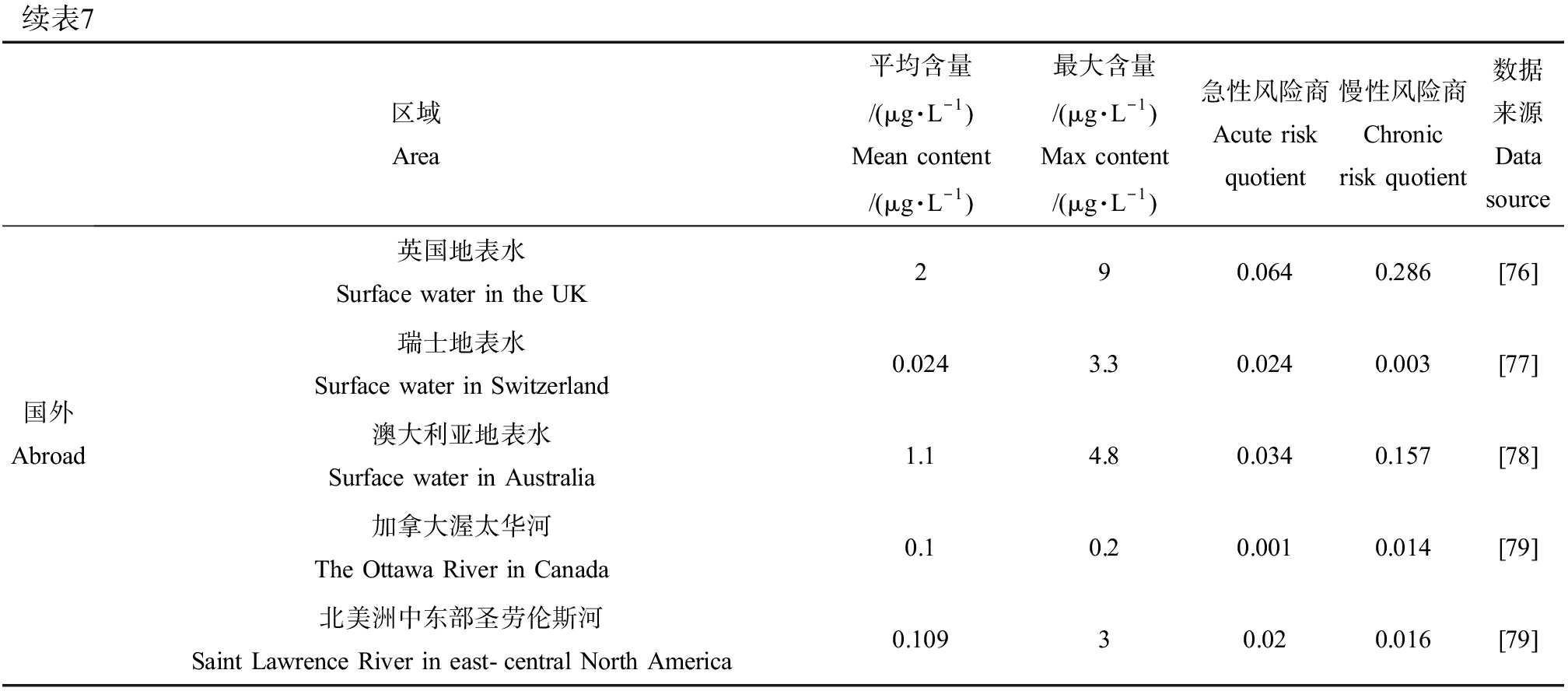
续表7区域Area平均含量/(μg·L-1)Mean content/(μg·L-1)最大含量/(μg·L-1)Max content/(μg·L-1)急性风险商Acute risk quotient慢性风险商Chronic risk quotient数据来源Data source国外Abroad英国地表水Surface water in the UK290.064 0.286 [76]瑞士地表水Surface water in Switzerland0.0243.30.0240.003[77]澳大利亚地表水Surface water in Australia1.14.80.034 0.157 [78]加拿大渥太华河The Ottawa River in Canada0.10.20.001 0.014 [79]北美洲中东部圣劳伦斯河Saint Lawrence River in east-central North America0.10930.020.016[79]
3 讨论(Discussion)
3.1 2种推导方法结果对比
TPR法和SSD法推导出草甘膦的CMC、CCC、SWQC和LWQC分别为0.12、0.035、0.14和0.007 mg·L-1。本文对草甘膦水质基准结果进行比较,发现2种方法推导的急性水质基准值相差不大,差距在一个数量级范围内,但慢性水质基准值存在巨大差异,这与推导过程中最终采用不同物种有关。
TPR法推导的水质基准值与受草甘膦影响最敏感的4个属的毒性数据有密切关系,排列后筛选出的数据在TPR法的运行过程中具有很大的作用。上述差异产生的原因主要为TPR法最终采用累积概率最接近0.05的4个属的毒性数据,该方法很难避免因个别物种的毒性数据过大或过小引起的水质基准偏差,且现能收集的慢性毒性数据较少,不能满足TPR法高数据量的标准。而SSD法通过EES-SSD软件选择出最佳拟合模型对草甘膦的短期及长期基准值进行推导,可以较好地避免水质基准偏差,且与TPR法对比,SSD法使用了全部的毒性数据进行水质基准值推导,降低了特殊非正常值对推导结果的影响,更具统计学意义,并且大部分学者认为SSD法是推导基准值的高效方法[80]。如,王莉等[81]利用SSD法推导了十二烷基苯磺酸钠淡水水质基准,并在研究中提到毒性数据用SSD法进行拟合时,具有综合考虑平方差以及保护95%淡水水生生物的优点,且SSD法综合所有毒性数据,计算出的基准值更具有普适性。综上,根据本研究物种慢性毒性数据量少和2种推导方法适用性的特点,最终决定用SSD法推导的水质基准值作为草甘膦的短期和长期水质基准推荐阈值。
本文采用SSD法推导水质基准值,其中急性和慢性毒性数据均采用传统的Normal、Log-normal、Logistic和Log-logistic模型进行拟合,依据平方差和保护95%淡水水生生物标准选取Logistic模型作为最佳拟合模型,但不否认存在更高拟合度的函数模型,该问题需要国内外学者深入研究。广泛使用的TPR法和SSD法对水生生物物种的数量比例差异问题欠缺考虑,但有部分研究者完善改进了该2种推导方法,如郝明辉[82]根据物种数量比例的差异适度改变累积概率,增加了推导出的氨氮水生生物水质基准值的可靠性。
3.2 国内外研究比较以及水质基准值对我国农药污染物环境标准的启示
国内外研究者均未对草甘膦的水质标准进行相关报道,故本文对国内外研究方法进行研究,并总结出精准的推导方法,以期获得高质量的草甘膦水质基准值。早在1960年,美国开展了污染物水质基准研究,以达到保护水生生物和人体健康的目的,澳大利亚、欧盟、世界卫生组织和加拿大也随后根据各地水质特点制定相关基准指南[1,83-86]。US EPA优先提出使用TPR法推导淡水水质基准值;新西兰、澳大利亚推荐使用高、中、低可靠性触发值全方位保护生物安全,该触发值由SSD法推导而来,而经评价因子法或统计模型操作获得的低可靠性触发值准确性较低,仅作为临时比较值;加拿大运用评价因子法推导出完整基准值和临时基准值,分别由收集的慢、急性数据分析获取。据研究,不同国家基准推导方法和数据来源的差异会导致基准值不同,即使使用同种的推导方法,各国的气候、地貌和水文等因素也会影响水生生物毒性实验数据值最终影响推导的结果[87]。因此,研究者们应尽量使用本国实验数据以及开展本土物种毒性实验以进行满足我国国情的淡水水生生物水质基准研究。
《地表水环境质量标准》(GB 3838—2002)中尚未规定草甘膦的标准限值,故使用同类型有机磷除草剂敌敌畏的标准限值作为草甘膦的标准限值,以完成标准限值与本文推导基准值的比较。根据地表水环境功能和保护目标,将该标准中的地表水划成五大类,其中最少2类水体功能与一类标准相对应[88]。我国地表水环境质量标准中Ⅱ、Ⅲ类水体标准符合维护人体健康和水生生物正常生活的要求,且与水生生物水质基准的保护目标相吻合。该标准中,水环境污染物标准限值与欧盟饮用水水源的地表水标准有关,依据标准拟采用的草甘膦标准限值为0.05 mg·L-1,远高于本研究SSD法推导的草甘膦的短期水质基准值0.007 mg·L-1。经分析,标准值高于基准值,可认为我国发布的地表水环境质量标准中草甘膦的Ⅱ、Ⅲ类标准值不能满足淡水水生生物正常生活的要求。标准中,草甘膦标准限值局限于对生活饮用水特定项目的要求,但大多研究已表明,草甘膦对人体和水生生物均具有毒性作用。草甘膦短期基准阈值0.007 mg·L-1要比我国地表水环境质量标准中限值低0.043 mg·L-1,0.05 mg·L-1的草甘膦规定值可达到维护人体健康的目的,但水生生物对草甘膦的敏感性较强,故该限值不适用于维护水生生物正常生存代谢。由于本研究收集了国内外所有物种毒性实验数据,故存在推导的基准值不满足本土国情的情况,但存在一定的参考价值。根据本研究推导的草甘膦水质基准值,可为我国制定草甘膦标准限值提供参考,建议该标准限值为0.007mg·L-1。
3.3 国内外草甘膦生态风险评估
据表7所示,国内外不同淡水水域中的草甘膦浓度存在差异,与国外相比,我国仅6.7%的地表水草甘膦平均含量超过本研究推导的SWQC,且仅13%的地表水草甘膦平均含量大于LWQC,这说明我国对农药管控比较严格以及草甘膦不易通过某种介质进入水体,而国外20%的地表水草甘膦浓度超过LWQC,这说明国外对草甘膦的使用量较我国稍高。据统计,各地表水急性风险商范围为0~371.8,平均值为15.2;各地表水慢性风险商范围为0~965.7,平均值为41.7。其中,7.69%的水体为急性高风险水体,7.69%的水体为急性中风险水体,15.38%的水体为急性低风险水体,69.23%的水体为无风险水体,故急性风险商中,主要以无风险为主;而在慢性风险商中,主要以低风险为主,15.38%的水体为高风险,3.85%的水体为中风险,42.31%的水体为低风险,仅38.46%的水体为无风险。总体来说,国内外淡水水域受草甘膦影响较小,能够不影响淡水中80.7%的生物物种正常生存代谢,但个别地区水域草甘膦含量较高,这可能与使用大量草甘膦密切相关,如我国太湖流域农业耕地面积达到151万hm2,使用除草剂量达到4.05 kg·hm-2[63],而且当地水旱轮作、稻-麦轮作、稻-油轮作方式的推广加剧了除草剂对水环境的污染。总之,较国外相比,我国水环境受草甘膦除草剂的污染较轻,很大程度地保护了我国淡水水生生物的正常生存。相关部门应对江苏省南京市太湖和广东省广州市珠江水源地加强农药管理,并完善当地地表水环境质量标准关于草甘膦标准限制的规定,以全面降低我国淡水水环境中草甘膦含量。
本研究表明:
(1)考虑到草甘膦的淡水水生生物慢性毒性数据量较少,本文综合对比了TPR法和SSD法的适用性及优缺点,最终选择SSD法的推导值作为草甘膦的淡水水生生物水质基准值,即SWQC和LWQC分别为0.14 mg·L-1和0.007 mg·L-1。
(2)鉴于我国水质基准的不断完善,相关部门应根据我国本土物种和水环境生态系统特点构建符合我国国情的淡水水生生物水质基准体系。且我国地表水环境质量标准中缺乏关于草甘膦标准限制值,制定标准限制值可以参考SSD法推导的LWQC值0.007 mg·L-1。
(3)我国地表水中草甘膦污染物急性和慢性风险商比国外均较小,但我国太湖流域水环境受草甘膦影响最为严重,建议对太湖区域重点治理,并且相关部门需加强对该区域草甘膦除草剂使用的管理。
[1] UnitedStates Environmental Protection Agency(US EPA).Guidelines for deriving numerical national water quality criteria for protection of aquatic organisms and their uses[R].Washington DC: Office of Research and Development, 1985: 1-57
[2] 何艳娇.太湖优控污染物重金属锌和镉水质基准研究[D].合肥: 安徽建筑大学, 2021: 1-12
He Y J.Study on water quality standard of heavy metal zinc and cadmium in Taihu Lake[D].Hefei: Anhui Jianzhu University, 2021: 1-12(in Chinese)
[3] 刘群.太湖重金属铅和铬的保护水生生物水质基准研究[D].合肥: 安徽建筑大学, 2021: 1-13
Liu Q.Study on water quality criteria for protecting aquatic organisms of lead and chromium in Taihu Lake[D].Hefei: Anhui Jianzhu University, 2021: 1-13(in Chinese)
[4] 马燕.中美银的淡水生物水质基准研究[D].青岛: 青岛理工大学, 2014: 1-6
Ma Y.Aquatic life ambient freshwater quality criteria for silver ion in China and USA[D].Qingdao: Qingdao Technology University, 2014: 1-6(in Chinese)
[5] 刘婷婷, 郑欣, 闫振广, 等.我国水生生物的二甲苯基准阈值探讨及其在风险评估中的初步应用[J].生态毒理学报, 2015, 10(1): 130-138
Liu T T, Zheng X, Yan Z G, et al.Derivation of freshwater aquatic life water quality criteria for xylene and their preliminary application in risk assessment in China[J].Asian Journal of Ecotoxicology, 2015, 10(1): 130-138(in Chinese)
[6] 刘俐, 李亚兵, 刘红玲.太湖保护水生生物2, 4-二氯苯酚基准研究[J].环境化学, 2020, 39(7): 1774-1787
Liu L, Li Y B, Liu H L.Derivation of water quality criteria of 2,4-dichlorophenol for protection of aquatic life in Tai Lake[J].Environmental Chemistry, 2020, 39(7): 1774-1787(in Chinese)
[7] 曹晶潇, 陈晓泳, 陆素芬, 等.广西坡豪湖氨氮水生生物水质基准及生态风险评估[J].贵州农业科学, 2019, 47(4): 145-149
Cao J X, Chen X Y, Lu S F, et al.Water quality criteria and ecological risk assessment of aquatic organisms with ammonia nitrogen in Pohao Lake in Guangxi[J].Guizhou Agricultural Sciences, 2019, 47(4): 145-149(in Chinese)
[8] 中华人民共和国环境保护部.淡水水生生物水质基准制定技术指南: HJ 831—2017[S].北京: 中国环境出版社, 2017
[9] 中华人民共和国生态环境部.淡水水生生物水质基准制定指南(修订征求意见稿): HJ 831—2022[S].北京: 中国环境出版社, 2022
[10] 魏琛, 宋丽婧, 杨卫萍, 等.贵阳市地表水中草甘膦农药残留研究[J].环境科学与技术, 2016, 39(3): 126-130
Wei C, Song L J, Yang W P, et al.Research on glyphosate pesticide residue in surface water in Guiyang[J].Environmental Science &Technology, 2016, 39(3): 126-130(in Chinese)
[11] Mercurio P, Flores F, Mueller J F, et al.Glyphosate persistence in seawater[J].Marine Pollution Bulletin, 2014, 85(2): 385-390
[12] 卢信, 赵炳梓, 张佳宝, 等.除草剂草甘膦的性质及环境行为综述[J].土壤通报, 2005, 36(5): 785-790
Lu X, Zhao B Z, Zhang J B, et al.Property and environmental behavior of herbicide glyphosate[J].Chinese Journal of Soil Science, 2005, 36(5): 785-790(in Chinese)
[13] 徐怡, 刘其根, 胡忠军, 等.10种农药对克氏原螯虾幼虾的急性毒性[J].生态毒理学报, 2010, 5(1): 50-56
Xu Y, Liu Q G, Hu Z J, et al.Acute toxicity of ten pesticides to larval red swamp crayfish Procambarus clarkii[J].Asian Journal of Ecotoxicology, 2010, 5(1): 50-56(in Chinese)
[14] 冯承莲, 吴丰昌, 赵晓丽, 等.水质基准研究与进展[J].中国科学: 地球科学, 2012, 42(5): 646-656
Feng C L, Wu F C, Zhao X L, et al.Research and progress of water quality standards[J].Scientia Sinica(Terrae), 2012, 42(5): 646-656(in Chinese)
[15] Posthuma L, Suter G W, Traas T P.Species sensitivity distributions in ecotoxicology[M].Boca Raton, CRC: Lewis Publishers, 2002
[16] 孟伟, 吴丰昌, 主编.中国环境科学研究院编.水质基准的理论与方法学导论[M].北京: 科学出版社, 2010: 36-56
[17] 李会仙, 吴丰昌, 陈艳卿, 等.我国水质标准与国外水质标准/基准的对比分析[J].中国给水排水, 2012, 28(8): 15-18
Li H X, Wu F C, Chen Y Q, et al.Comparative analysis on Chinese water quality standards and foreign water quality standards/criteria[J].China Water & Wastewater, 2012, 28(8): 15-18(in Chinese)
[18] Wu F C, Meng W, Zhao X L, et al.China embarking on development of its own national water quality criteria system[J].Environmental Science &Technology, 2010, 44(21): 7992-7993
[19] Jin X W, Wang Y Y, Giesy J P, et al.Development of aquatic life criteria in China: Viewpoint on the challenge[J].Environmental Science and Pollution Research International, 2014, 21(1): 61-66
[20] 中国国家标准化管理委员会, 中华人民共和国国家质量监督检验检疫总局.淡水水生生物水质基准制定技术指南: HJ 831—2017[S].北京: 中国国家标准化管理委员会, 中华人民共和国国家质量监督检验检疫总局, 2017
[21] Stephen C E, Mount D I, Hansen D J, et al.Guidelines for deriving numerical national water quality criteria for the protection of aquatic organisms and their uses[R].Washington D C: US Environmental Protection Agency, 1985
[22] Antón F A, Laborda E, de Ariz M.Acute toxicity of the herbicide glyphosate to fish[J].Chemosphere, 1994, 28(4): 745-753
[23] Ma J, Feng Y, Xie W, et al.Immune response in common carp(Cyprinus carpioL.)following glyphosate-exposure[J].Toxin Reviews, 2015, 34(4): 1-6
[24] Ma J G, Li X Y.Alteration in the cytokine levels and histopathological damage in common carp induced by glyphosate[J].Chemosphere, 2015, 128: 293-298
![]() I, et al.Biochemical and histopathological effects of glyphosate on carp,Cyprinus carpioL.[J].Bulletin of Environmental Contamination and Toxicology, 1996, 56(2): 295-302
I, et al.Biochemical and histopathological effects of glyphosate on carp,Cyprinus carpioL.[J].Bulletin of Environmental Contamination and Toxicology, 1996, 56(2): 295-302
[26] Pereira A G, Jaramillo M L, Remor A P, et al.Low-concentration exposure to glyphosate-based herbicide modulates the complexes of the mitochondrial respiratory chain and induces mitochondrial hyperpolarization in the Danio reriobrain[J].Chemosphere, 2018, 209: 353-362
[27] 傅建炜, 史梦竹, 李建宇, 等.草甘膦对草鱼、鲢鱼和鲫鱼的毒性[J].生物安全学报, 2013, 22(2): 119-122
Fu J W, Shi M Z, Li J Y, et al.Toxicity of glyphosate on grass carp(Ctenopharyngodon idellus), chub(Hypophthalmictuthys molitrix)and crucian(Carassius auratus)[J].Journal of Biosafety, 2013, 22(2): 119-122(in Chinese)
[28] Currie Z, Prosser R S, Rodriguez-Gil J L, et al.Toxicity of Cúspide 480SL®spray mixture formulation of glyphosate to aquatic organisms[J].Environmental Toxicology and Chemistry, 2015, 34(5): 1178-1184
[29] Wan M T, Watts R G, Moul D J.Effects of different dilution water types on the acute toxicity to juvenile Pacific salmonids and rainbow trout of glyphosate and its formulated products[J].Bulletin of Environmental Contamination and Toxicology, 1989, 43(3): 378-385
[30] Mitchell D G, Chapman P M, Long T J.Acute toxicity of Roundup and Rodeo herbicides to rainbow trout, chinook, and coho salmon[J].Bulletin of Environmental Contamination and Toxicology, 1987, 39(6): 1028-1035
[31] Servizi J A, Gordon R W, Martens D W.Acute toxicity of garlon 4 and roundup herbicides to salmon, Daphnia, and trout[J].Bulletin of Environmental Contamination and Toxicology, 1987, 39(1): 15-22
[32] Morgan M J, Kiceniuk J W.Response of rainbow trout to a two month exposure to Vision®, a glyphosate herbicide[J].Bulletin of Environmental Contamination and Toxicology, 1992, 48(5): 772-780
[33] Relyea R A, Jones D K.The toxicity of roundup original max®to 13 species of larval amphibians[J].Environmental Toxicology and Chemistry, 2009, 28(9): 2004
[34] Edginton A N, Sheridan P M, Stephenson G R, et al.Comparative effects of pH and vision herbicide on two life stages of four anuran amphibian species[J].Environmental Toxicology and Chemistry, 2004, 23(4): 815-822
[35] Howe C M, Berrill M, Pauli B D, et al.Toxicity of glyphosate-based pesticides to four North American frog species[J].Environmental Toxicology and Chemistry, 2004, 23(8): 1928-1938
[36] Uchida M, Takumi S, Tachikawa K, et al.Toxicity evaluation of glyphosate agrochemical components using Japanese medaka(Oryzias latipes)and DNA microarray gene expression analysis[J].The Journal of Toxicological Sciences, 2012, 37(2): 245-254
[37] Chandrasekera W U, Weeratunga N P.The lethal impacts of roundup®(glyphosate)on the fingerlings of guppy, Poecilia reticulataPeters, 1859[J].Asian Fisheries Science, 2011, 24(4): 367-378
[38] Abdelghani A A, Tchounwou P B, Anderson A C, et al.Toxicity evaluation of single and chemical mixtures of roundup, Garlon-3A, 2, 4-D, and syndets surfactant to channel catfish(Ictalurus punctatus), bluegill sunfish(Lepomis microchirus), and crawfish(Procambarusspp.)[J].Environmental Toxicology and Water Quality, 1997, 12(3): 237-243
[39] Tsui M T K, Chu L M.Comparative toxicity of glyphosate-based herbicides: Aqueous and sediment[J].Archives of Environmental Contamination and Toxicology, 2004, 46(3): 316-323
[40] 李佳.绿藻和水溞对草甘膦和氰氟草酯的响应[D].重庆: 西南大学, 2018: 27-30
Li J.Response of green algea and Daphniato glyphosate and cyhalofop-butyl[D].Chongqing: Southwest University, 2018: 27-30(in Chinese)
[41] Al-Omar M A, Hassan N A.Simple and rapid method for the detection of early signs of toxicity in Daphnia magnaStraus[J].Bulletin of Environmental Contamination and Toxicology, 2000, 65(5): 553-559
[42] Mensah P K, Palmer C G, Muller W J.Derivation of South African water quality guidelines for Roundup(®)using species sensitivity distribution[J].Ecotoxicology and Environmental Safety, 2013, 96: 24-31
[43] Henry C J, Higgins K F, Buhl K J.Acute toxicity and hazard assessment of Rodeo®, X-77 Spreader®, and Chem-Trol®to aquatic invertebrates[J].Archives of Environmental Contamination and Toxicology, 1994, 27(3): 392-399
[44] Folmar L C, Sanders H O, Julin A M.Toxicity of the herbicide glyphosate and several of its formulations to fish and aquatic invertebrates[J].Archives of Environmental Contamination and Toxicology, 1979, 8(3): 269-278
[45] 史建华, 刘智俊, 陆锦天, 等.草甘膦对中华绒螯蟹幼蟹的毒性影响[J].水产科技情报, 2015, 42(5): 239-242
Shi J H, Liu Z J, Lu J T, et al.Toxic effects of glyphosate on juvenile Eriocheir sinensis[J].Fisheries Science & Technology Information, 2015, 42(5): 239-242(in Chinese)
[46] Xi Y L, Feng L K.Effects of thiophanate-methyl and glyphosate on asexual and sexual reproduction in the rotifer Brachionus calyciflorusPallas[J].Bulletin of Environmental Contamination and Toxicology, 2004, 73(4): 644-651
[47] Relyea R A.The lethal impacts of Roundup and predatory stress on six species of North American tadpoles[J].Archives of Environmental Contamination and Toxicology, 2005, 48(3): 351-357
[48] Weeks Santos S, Gonzalez P, Cormier B, et al.A glyphosate-based herbicide induces sub-lethal effects in early life stages and liver cell line of rainbow trout, Oncorhynchus mykiss[J].Aquatic Toxicolog, 2019, 216: 105291
[49] Uren Webster T M, Laing L V, Florance H, et al.Effects of glyphosate and its formulation, roundup, on reproduction in zebrafish(Danio rerio)[J].Environmental Science &Technology, 2014, 48(2): 1271-1279
[50] Williams B K, Semlitsch R D.Larval responses of three midwestern anurans to chronic, low-dose exposures of four herbicides[J].Archives of Environmental Contamination and Toxicology, 2010, 58(3): 819-827
[51] Smith C M, Vera M K M, Bhandari R K.Developmental and epigenetic effects of Roundup and glyphosate exposure on Japanese medaka(Oryzias latipes)[J].Aquatic Toxicology, 2019, 210: 215-226
[52] Cuhra M, Traavik T, Bøhn T.Clone-and age-dependent toxicity of a glyphosate commercial formulation and its active ingredient in Daphnia magna[J].Ecotoxicology, 2013, 22(2): 251-262
[53] Huang X J, Fong S, Deanovic L, et al.Toxicity of herbicides in highway runoff[J].Environmental Toxicology and Chemistry, 2005, 24(9): 2336-2340
[54] Morris A, Murrell E G, Klein T, et al.Effect of two commercial herbicides on life history traits of a human disease vector, Aedes aegypti, in the laboratory setting[J].Ecotoxicology, 2016, 25(5): 863-870
[55] Kielak E, Sempruch C, Mioduszewska H, et al.Phytotoxicity of Roundup Ultra 360 SL in aquatic ecosystems: Biochemical evaluation with duckweed(Lemna minorL.)as a model plant[J].Pesticide Biochemistry and Physiology, 2011, 99(3): 237-243
[56] SobreroM C, Rimoldi F, Ronco A E.Effects of the glyphosate active ingredient and a formulation on Lemna gibbaL.[J].Bulletin of Environmental Contamination and Toxicology, 2007, 79(5): 537-543
[57] 郭文景, 张志勇, 符志友, 等.锑的淡水水质基准及其对我国水质标准的启示[J].中国环境科学, 2020, 40(4): 1628-1636
Guo W J, Zhang Z Y, Fu Z Y, et al.Derivation of aquatic life water quality criteria for antimonyin freshwater and its implication for water quality standard in China[J].China Environmental Science, 2020, 40(4): 1628-1636(in Chinese)
[58] 刘征涛.水环境质量基准方法与应用[M].北京: 科学出版社, 2012: 138-145
[59] Parkhurst B R, Warren W.Aquatic ecological risk assessment: A multi-tiered approach, Project 91-AER-1 [R].Alexandria(VA): Water Environment Research Foundation, 1996
[60] European Chemicals Bureau(ECB).Technical guidance document on risk assessment in support of Commission Directive 93/67/EEC on risk assessment for new notified substances, Commission Regulation(EC)No.1488/94 on risk assessment for existing substances and Directive 98/8/EC of the European Parliament and of the Council concerning the placing of biocidal products on the market.Part Ⅱ: Environmental risk sssessment[R].Ispra, Italy: European Chemicals Bureau, European Commission Joint Research Center, European Communities, 2003
[61] 王静, 刘铮铮, 许行义, 等.浙江省饮用水源有机毒物污染特征及健康风险研究[J].环境污染与防治, 2010, 32(7): 29-33
Wang J, Liu Z Z, Xu X Y, et al.Study on pollution pattern and health risk of organic toxicants in Zhejiang source water[J].Environmental Pollution & Control, 2010, 32(7): 29-33(in Chinese)
[62] 何书海, 曹小聪, 吴海军, 等.直接进样超高效液相色谱-三重四极杆质谱法快速测定环境水样中草甘膦、氨甲基膦酸、草铵膦及乙烯利残留[J].色谱, 2019, 37(11): 1179-1184
He S H, Cao X C, Wu H J, et al.Rapid determination of glyphosate, aminomethyl phosphonic acid, glufosinate, and ethephon residues in environmental water by direct injection-ultra performance liquid chromatography-triple quadrupole mass spectrometry[J].Chinese Journal of Chromatography, 2019, 37(11): 1179-1184(in Chinese)
[63] 李祥平, 齐剑英, 陈永亨.离子色谱法测定环境水体中的卤乙酸和草甘膦[J].应用化学, 2009, 26(4): 447-450
Li X P, Qi J Y, Chen Y H.Determination of dichloroacetic acid, trichloroacetic acid and glyphosate in environmental water by ion chromatography with large volume direct injection[J].Chinese Journal of Applied Chemistry, 2009, 26(4): 447-450(in Chinese)
[64] 范瑾煜, 耿金菊, 王晓蓉.离子色谱法测定太湖水体中甘草磷含量[C]//第六届全国环境化学大会暨环境科学仪器与分析仪器展览会摘要集.上海: 上海师范大学, 复旦大学, 上海交通大学, 2011: 22-223
[65] 郭浩, 张松, 宋胜利, 等.亲水性相互作用色谱-串联质谱联用法检验鱼塘水中的草甘膦[J].分析试验室, 2013, 32(6): 93-96
Guo H, Zhang S, Song S L, et al.Determination of glyphosate residues in fishpond water using hydrophilic interaction chromatography tandem mass spectrometry[J].Chinese Journal of Analysis Laboratory, 2013, 32(6): 93-96(in Chinese)
[66] Peruzzo P J, Porta A A, Ronco A E.Levels of glyphosate in surface waters, sediments and soils associated with direct sowing soybean cultivation in north pampasic region of Argentina[J].Environmental Pollution, 2008, 156(1): 61-66
[67] 李健平, 王晓婧, 王缘, 等.HPLC-MS-MS法和IC法测定水中2,4-D、草甘膦、灭草松含量的对比研究[J].中国公共卫生管理, 2021, 37(5): 641-643
Li J P, Wang X J, Wang Y, et al.Comparison of HPLC-MS-MS and IC in determination of 2,4-D, glyphosate and bentazone in water[J].Chinese Journal of Public Health Management, 2021, 37(5): 641-643(in Chinese)
[68] 王敏, 李广益, 高慧, 等.高效液相色谱-柱后衍生法测定水中草甘膦[J].食品科技, 2017, 42(2): 295-297
Wang M, Li G Y, Gao H, et al.Determination of glyphosate in water by high performance liquid chromatography with post column derivatization[J].Food Science and Technology, 2017, 42(2): 295-297(in Chinese)
[69] 安静.全自动固相萃取-气相色谱质谱法监测地表水中的5种有机磷类农药残留量[J].中国测试, 2019, 45(11): 61-65
An J.Automatic SPE-GC/MS method for determination of 5 organophosphorus pesticides residues in surface water[J].China Measurement & Test, 2019, 45(11): 61-65(in Chinese)
[70] 宋洲, 罗火焰, 刘田, 等.柱前衍生高效液相色谱法测定地下水中草甘膦[J].资源环境与工程, 2020, 34(S2): 159-163
Song Z, Luo H Y, Liu T, et al.Determination of glyphosate in groundwater by high performance liquid chromatography combined with pre-column derivatization[J].Resources Environment & Engineering, 2020, 34(S2): 159-163(in Chinese)
[71] 沈路遥, 彭自然, 何文辉, 等.罗氏沼虾养殖塘草甘膦残留特征及生态风险评估[J].上海海洋大学学报, 2021, 30(5): 821-827
Shen L Y, Peng Z R, He W H, et al.Residual characteristics and ecological risk assessment of glyphosate in Macrobrachium rosenbergiiculture ponds[J].Journal of Shanghai Ocean University, 2021, 30(5): 821-827(in Chinese)
[72] Lutri V F, Matteoda E, Blarasin M, et al.Hydrogeological features affecting spatial distribution of glyphosate and AMPA in groundwater and surface water in an agroecosystem.Córdoba, Argentina[J].Science of the Total Environment, 2020, 711: 134557
[73] Mauffrey F, Baccara P Y, Gruffaz C, et al.Bacterial community composition and genes for herbicide degradation in a stormwater wetland collecting herbicide runoff[J].Water, Air, &Soil Pollution, 2017, 228(12): 452
[74] Tang T, Bo⊇nne W, Desmet N, et al.Quantification and characterization of glyphosate use and loss in a residential area[J].The Science of the Total Environment, 2015, 517: 207-214
[75] Feng J C, Thompson D G, Reynolds P.Fate of glyphosate in a Canadian forest watershed.1.Aquatic residues and off-target deposit assessment[J].Journal of Agricultural and Food Chemistry, 1990, 38: 1110-1118
[76] Ramwell C T, Kah M, Johnson P D.Contribution of household herbicide usage to glyphosate and its degradate aminomethylphosphonic acid in surface water drains[J].Pest Management Science, 2014, 70(12): 1823-1830
[77] Hanke I, Wittmer I, Bischofberger S, et al.Relevance of urban glyphosate use for surface water quality[J].Chemosphere, 2010, 81(3): 422-429
[78] Okada E, Allinson M, Barral M P, et al.Glyphosate and aminomethylphosphonic acid(AMPA)are commonly found in urban streams and wetlands of Melbourne, Australia[J].Water Research, 2020, 168: 115139
[79] Montiel-León J M, Munoz G, Vo Duy S, et al.Widespread occurrence and spatial distribution of glyphosate, atrazine, and neonicotinoids pesticides in the St.Lawrence and tributary rivers[J].Environmental Pollution, 2019, 250: 29-39
[80] Wu F C, Mu Y S, Chang H, et al.Predicting water quality criteria for protecting aquatic life from physicochemical properties of metals or metalloids[J].Environmental Science &Technology, 2013, 47(1): 446-453
[81] 王莉, 刘静, 柳振铎, 等.十二烷基苯磺酸钠淡水水质基准初探及生态风险评估[J].生态毒理学报, 2021, 16(3): 280-290
Wang L, Liu J, Liu Z D, et al.Preliminary investigation of freshwater water quality criteria and ecological risk assessment of LAS[J].Asian Journal of Ecotoxicology, 2021, 16(3): 280-290(in Chinese)
[82] 郝明辉.清潩河流域氨氮水生生物基准研究[D].郑州: 郑州大学, 2018: 58-75
Hao M H.Preliminary aquatic life criteria development of ammonia in Qingyi River basin[D].Zhengzhou: Zhengzhou University, 2018: 58-75(in Chinese)
[83] Australian and New Zealand Environment and Conservation Council(ANZECC), Agriculture and Resource Management Council of Australia and New Zealand(ARMCANZ).National water quality management strategy, Australian and New Zealand guidelines for fresh and marine water quality[S].Canberra: ANZECC and ARMCANZ, 2000
[84] Caux P, Kent R, Fan G T, et al.Protocols for deriving Canadian water quality guidelines for the protection of agricultural water uses.Winnipeg: Canadian Council of Ministers of the Environment 2008
[85] European Union(EU).EU’s drinking water standards[S].Luxembourg: Office for Official Publications of the European Communities, 2004
[86] World Health Organization(WHO).Guidelines for drinking-water quality[R].Geneva: World Health Organization, 2011
[87] 黄炜惠, 李文攀, 霍守亮, 等.美国溶解氧基准标准及其对我国的启示[J].环境科学研究, 2021, 34(6): 1338-1346
Huang W H, Li W P, Huo S L, et al.US dissolved oxygen criterion, standard and its revelation for China[J].Research of Environmental Sciences, 2021, 34(6): 1338-1346(in Chinese)
[88] 张远, 林佳宁, 王慧, 等.中国地表水环境质量标准研究[J].环境科学研究, 2020, 33(11): 2523-2528
Zhang Y, Lin J N, Wang H, et al.Research on environmental quality standard for surface water[J].Research of Environmental Sciences, 2020, 33(11): 2523-2528(in Chinese)